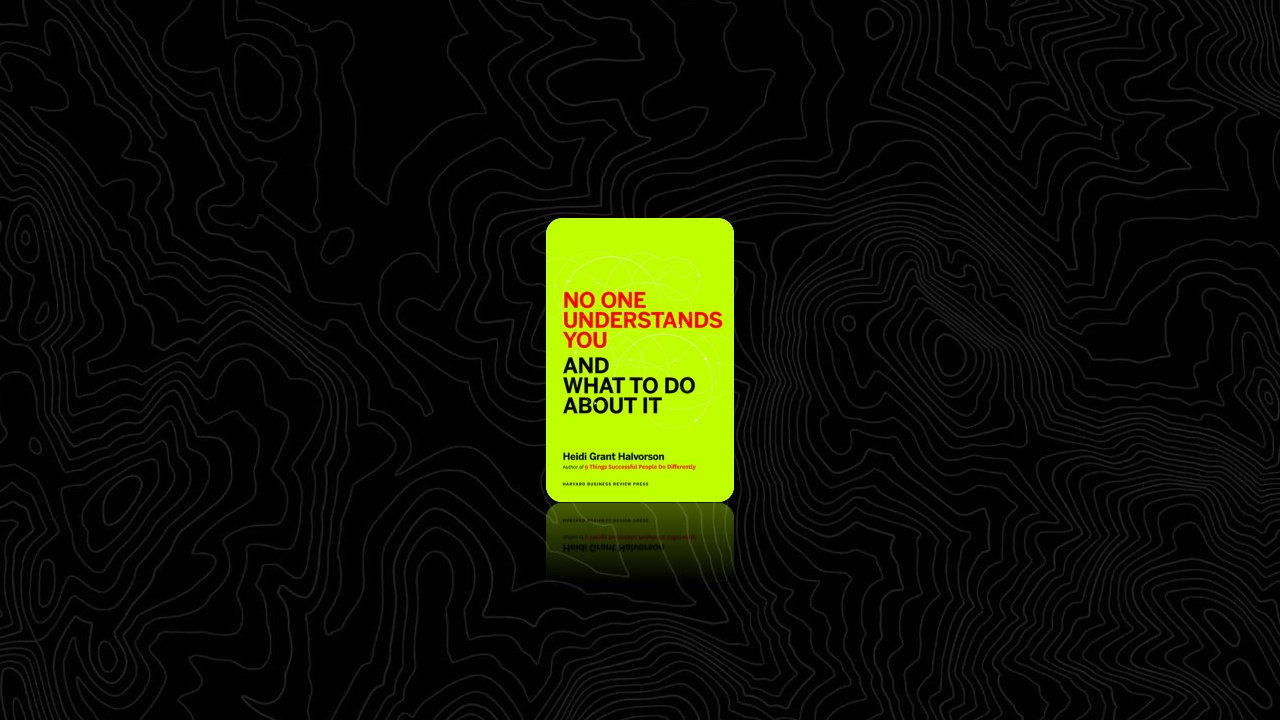You Are Surprisingly Hard to Understand
We don’t communicate nearly as much information as we think we do. When you say, “He knows what I meant” or “I made myself clear,” chances are, he doesn’t and you didn’t. Our faces are not nearly as expressive as we think they are; mild boredom can look an awful lot like mild interest or mild concern.
We fall prey to two assumptions: (1) that other people see us objectively as we are and (2) that other people see us as we see ourselves. In fact, our perceivers don’t even agree with each other on what they see in us.
There are two main reasons we’re so hard to understand: First, no one is actually an open book. And second, our actions are always subject to interpretation.
Your Observers Are Cognitive Misers (and So Are You)
Much of the time, we are cognitive misers—spending as little of our mental energy as we have to in order to get the job done. So when we try to make sense of other people, we use lots of shortcuts and assumptions.
The most powerful of these shortcuts is perhaps the confirmation bias—put simply, people see what they expect to see.
Thanks to the primacy effect, a perceiver’s first impression of you is likely to be a lasting impression and to influence how he or she interprets everything else about you. So, no pressure.
Perceivers don’t (necessarily) use stereotypes because they are horrible bigots. Often, they make these assumptions because the human brain is wired to use information about categories to understand members of those categories—including people. Also, stereotypes work most of their effects unconsciously, so your perceiver can say “I never stereotype!” with a straight face and have no idea that he or she does it all the time.
Generally speaking, other people will assume you share their opinions and attitudes, but not their abilities and moral character. With respect to the latter, they believe they are more talented and less corruptible than you are. Try not to take it personally.
The Trust Lens
The very first thing another person will seek to determine about you is whether he or she can trust you—in broad strokes, whether you are a friend or foe.
The decision to trust is made almost entirely unconsciously and is based on the extent to which you project warmth and competence. Warmth is a signal that you have good intentions toward your perceiver; competence signals that you are capable of acting on those intentions.
Convey warmth by paying attention—make eye contact and hold it, smile, nod to indicate understanding. Show empathy and concern, when appropriate. Above all, be fair and be true to your word. And be willing to trust first, when necessary, to put the other person at ease.
Convey competence by making eye contact (yes, it’s good for competence, too) and sitting up straight. Don’t advertise your personal demons. Don’t sell yourself short, but don’t brag either—a little bit of modesty goes a long way to impressing others. And when you aren’t feeling particularly competent, adopt a power pose.
Leaders should always be careful to prioritize warmth, not competence, when trying to inspire trust and loyalty.
The Power Lens
People with (relatively) more power perceive you differently. In large part, this comes from focusing more on achieving their own goals and from being less interested in the concerns and perspectives of others. As a result, they take lots of shortcuts and have less complex, nuanced views of other people.
Power depends on context—someone with more power than you in a particular point in time, in a specific situation, may have less power in another. Power is dynamic and changing. We take the power lens on and off accordingly.
Power causes perceivers to rely more heavily on stereotypes and prior expectations. This makes it more difficult for you to distinguish yourself as a unique individual in their eyes.
High-power perceivers can be accurate, when accuracy is necessary for them to reach their goal. That is why instrumentality is so important—be someone who helps the powerful person achieve his or her goals, and the perceiver will find it worth the time and mental energy to see you for who you really are.
The Ego Lens
The ego lens has one goal—to protect (and enhance) the perceiver’s self-esteem. Thanks to its robust functioning, most of us tend to see ourselves as smarter, more attractive, and more morally upstanding than the average person. We take credit for our successes and blame our failures on the circumstances, other people, or dumb luck. All of this isn’t exactly admirable, but it gets the job done.
The extent that a perceiver’s self-esteem can be threatened by your accomplishments and abilities is a function of how relevant they are (i.e., does the perceiver want the same accomplishments and abilities?) and how close you are (i.e., are you an active part of his or her life?). When relevance or closeness is low, the threat is diminished and you will be seen more accurately.
When both relevance and closeness are high, you are in trouble—the perceiver will somehow have to diminish you (mentally) or maintain greater distance from you to protect his or her self-esteem.
These ego lens processes go beyond individuals to the groups to which we belong. A success for someone in my group is my success, while a success for someone in your group is a threat to mine.
This is why forming a sense of us with your perceiver is so important—when you are part of the same group that your perceiver belongs to, your accomplishments and abilities can be a source of self-esteem for him or her, too.
Two other techniques—modesty and affirmation—can be useful in stopping an ego threat before it starts.
Eager Reward-Seekers and Vigilant Risk-Mitigators
When people are promotion focused, they are trying to end up better off than they are now. They embrace risk, work quickly, seize opportunities, and generate more creative and innovative ideas. They are also more likely to make mistakes, fail to foresee problems, and be overly optimistic.
When people are prevention focused, they are trying to hang on to what they already have and to keep things running smoothly. They are cautious, deliberate, and analytical. They plan effectively and are always prepared. They are also overly risk averse, inflexible, and too wedded to the status quo.
Everyone uses both focuses, depending on the context. But people also tend to have a dominant focus—a promotion or prevention lens that they are generally looking through.
Speaking the right motivational language when communicating with your perceiver is key. For a promotion-focused perceiver, frame your ideas in terms of potential gains or wins—as ways of ending up better off than you are now. Be optimistic, and appeal to emotion. For a prevention-focused perceiver, frame your ideas in terms of avoiding losses or mistakes—as ways of staying safe and secure. Be a realist, and enlist cold, hard facts.
The Clingy, Anxious Perceiver and the Aloof, Avoidant Perceiver
Beginning in childhood, we develop mental models of what relationships are like—and whether other people can be trusted to be there for us when we need them. For roughly half of adults (i.e., the securely attached), their model is adaptive, in that they are trusting and make and maintain relationships easily. For the other half, things aren’t so easy.
Anxiously attached adults are, as the name implies, very anxious about their relationships. They desperately want intimacy, while being constantly worried that their relationship partners will reject them. They come off as needy, clingy, and emotionally volatile.
To communicate effectively with an anxiously attached perceiver, it’s essential to avoid ambiguity—take care that you don’t inadvertently send a rejection signal (or one that could be construed as rejecting). Be reliable, be patient, and don’t take a person’s overblown reactions personally. It’s not about you.
Adults with avoidant attachment don’t trust other people to be there for them at all, so they studiously avoid intimacy and other connection so as to never be vulnerable to rejection. They appear cold, aloof, and unfriendly.
To communicate with the avoidant-attached, remember that a lack of warmth on their part does not necessarily signal hostility—it’s more about caution. Don’t try to warm things up by being overly friendly, because you will just make them uncomfortable. Relationships with these people take time to build, and it’s necessary to take the long view.
Conclusion: Becoming a Better Judge of Others—and of Yourself
Perceiving people—including yourself—accurately is perhaps the most difficult thing we humans do. People are complicated, and their words and deeds are riddled with ambiguity and open to interpretation. We don’t realize that’s the case, because the way our brains are wired makes perception feel so obvious and effortless. But it’s neither—which is why we so often screw it up.
If you want to come across the way you intend to—to have other people see you as you (think you) are or as you’d like to be seen—you are going to have to give them a hand. Remember that it doesn’t help to blame the perceiver for getting you wrong. Instead, try making it easier for him or her to get you right.


